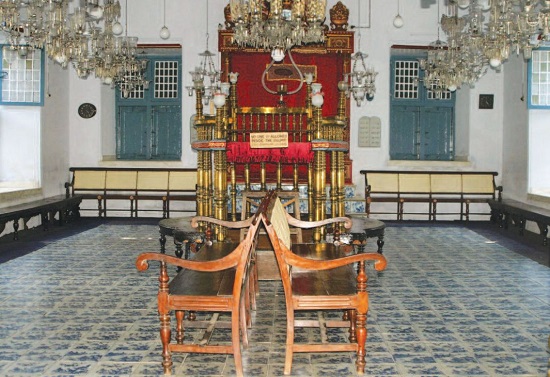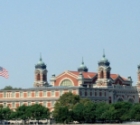
Cochin Synagogue which was built in 1568 and then rebuilt in 1664.
India is a very hot country. We landed in the city of Cochin in boiling hot weather. This city hugs India’s southwestern shore near the southern tip of India.
I had only one goal in visiting Cochin. I wanted to see the synagogue. It served what was once a large Jewish community. Almost 100 percent of the Jews of Cochin have immigrated to Israel and now have several active kibbutzim in the Galilee. But the story of the Jews of Cochin – when they arrived in India and what they contributed to the country - is amazing. The area around the synagogue is known as Jew Town and is still filled with an aroma of spices - a trade formerly dominated by the Jews. Our bus guide was not overly thrilled to take us to the synagogue. ‘‘It’s a very long walk,’’ he warned. The temperature outside our air-conditioned bus was over 35˚. I persisted, insisted and finally he agreed. He wasn’t exaggerating. We walked for about 20 minutes in that heat along “Jew Street” passing by many shops whose owners, according to the names outside, had obviously once been Jews. The names of the shops were Jewish names but today’s owners were Indians, not Jews.
There are those who believe the Jews of India originally came from Israel at the time of King Solomon. They called their old settlement “Shingly”. From the fifth to the fifteenth century the Jews in Cranganore had had an independent principality ruled over by a Prince of their own race and choice. The area was also called “Kerala”. Other historians believe that Jews came to India from Persia. Another theory is that they are the descendants of the Jews taken to Babylon by Nebuchadnezzar. However, the tradition of the Cochin Jews maintains that soon after the destruction of the second Temple in the first century CE, 10,000 Jews were allowed to settle in different parts of the country, and the majority made their home in Cranganore.*
The story of the Jews in this part of India is one of tolerance and even love. They were accepted and honored by almost all of the rulers in the area throughout the history of the Jews in India.
The synagogue was at the end of a very long alley. It was built in 1568 and rebuilt in 1664. It served as the home of the Jewish community until most of them left to settle in Israel. Laws in India had changed and many Jews were forced to work on the Sabbath. There was also a lack of marriage partners, and Israel offered better employment opportunities.
The interior of the synagogue is decorated with a gold bima in the center. Torah covers of gold shine in an open ark.Delicate highly-elaborate gas lamps hang from the ceiling and there is a very beautiful blue tiled floor. The tiles were imported from Canton, China. One can enter only in stockinged feet.The women’s section is hidden above the main area of the synagogue and is covered by decorated panels. A gold crown was presented to the synagogue by the Maharajah of Travancore in 1805.
The celebration of the 400th anniversary of the synagogue took place in 1968. It is open to tourists and despite the heat and the distance is well worth a visit.
*Source: “Kerala and Her Jews”
 Chanukah 5777
Chanukah 5777 Advertisers Directory 187
Advertisers Directory 187 ‘Give Peace a Chance’ Duo at Ceremony
‘Give Peace a Chance’ Duo at Ceremony (302x450)-1451381711.jpg) Odeon Oscar
Odeon Oscar The Jewish Connection
The Jewish Connection ellis island
ellis island Meira Applebaum
Meira Applebaum